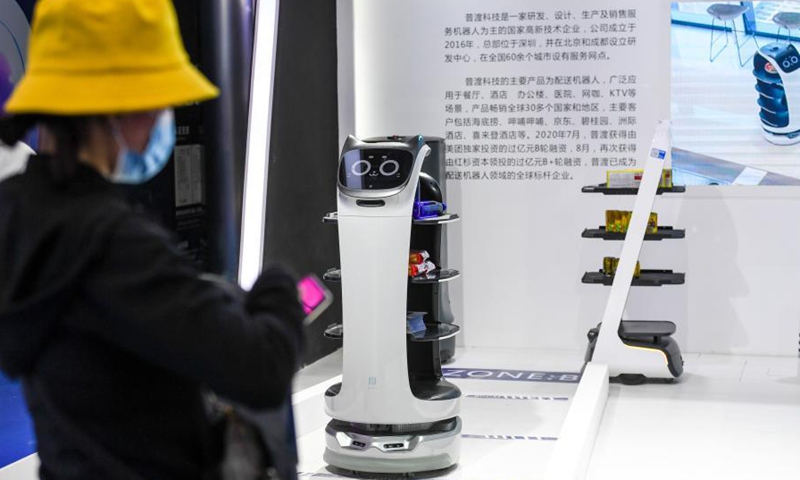
A delivery robot is seen at the 22nd China Hi-Tech Fair (CHTF) held in Shenzhen, south China's Guangdong Province, Nov. 11, 2020. (Xinhua/Mao Siqian)
The more vibrant part of the Chinese economy that typifies the nation's shift toward innovation-driven growth defied the fallout of the COVID-19 pandemic to generate more added value as a part of GDP, official data showed on Tuesday.
The country's new industries and business models continued on an upward trajectory despite the shockwaves from coronavirus and the complicated international situation, with the added value of the "three new" economy totaling 16.93 trillion yuan ($2.62 trillion), equivalent to 17.08 percent of GDP, 0.7 percentage points higher than the reading for the year before, the National Bureau of Statistics (NBS) said in a statement on its website on Tuesday.
The ratio is expected to roughly double to hit one-third of GDP by 2035 before climbing above 50 percent by the middle of the century when the country is envisioned to have accomplished the second centenary goal of building itself into a great modern socialist country in all respects, according to one economist.
The added value of the so-called "three new" economy for 2020 grew up 4.5 percent from the prior year, 1.5 percentage points higher than last year's GDP expansion in current price terms, per NBS.
The "three new" economy refers to a collection of economic activities that set the Chinese economy for sci-tech innovation-oriented growth.
Specifically, it comprises new economic activities resulting from the application of new scientific and technological achievements and new technologies, new links and chains deriving from existing industries that fit into diversified and personalized needs such as internet-enabled business activities, as well as the integration and reorganization of business operations.
The country's powerful logistics network and the prevalence of mobile payments have long been viewed as underpinning its internet economic prowess, providing a tailwind for the economy's swift rebooting, Tian Yun, former vice director of the Beijing Economic Operation Association, told the Global Times on Tuesday.
The rising added value of the "three new" economy is not a dividend of new behavior created by the coronavirus. Instead, it indicates that the country's vision for tech innovation-centric growth laid out in its 13th Five-Year Plan (2016-20) has been bearing fruit, laying the groundwork for the economy to quickly emerge from the COVID-19, according to Tian.
With China's continued push for domestic innovation, especially breakthroughs in bottle-check technologies, the "three new" economy to GDP ratio is on course to exceed 20 percent at the end of the 14th Five-Year Plan (2021-25) which prioritizes the development of the country's digital economy, the economist estimated.
Beyond that, the ratio will likely top one-third of GDP by 2035 when the economy is planned to achieve a set of long-range objectives, he continued, envisaging a qualitative transformation by 2050 when the economy might be declared an innovation-powered and trend-setting global economic powerhouse for its entirety.
Global Times




